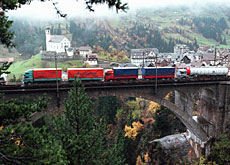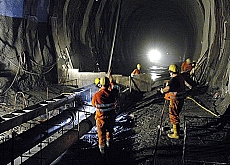Stately Simplon celebrates centenary

The Simplon rail tunnel linking Switzerland and Italy can look back on 100 years as a vital artery of the railways, with next year signalling a busy future ahead.
Officially inaugurated on May 19, 1906, it was for many years the longest in the world but it has never caught the spotlight as much as another major alpine tunnel – the Gotthard.
“The Simplon tunnel has been in the shadow of the Gotthard tunnel for a long time, but actually it’s a very important crossing because it was the first base tunnel,” Thomas Köppel, deputy director of the Swiss Federal Railways heritage foundation, told swissinfo.
“From France to Italy it still is the most direct way.”
Köppel, who is the co-author on a new book about the Simplon, describes the almost 20-kilometre-long Simplon tunnel as “revolutionary”, arguing it was the first modern tunnel.
“The Gotthard tunnel was basically artisanal handwork and this was the first [partly] machine-made tunnel.
“It’s interestingly also the first tunnel that was done with two bores which were connected, so it’s actually a very safe tunnel, even though it’s a hundred years old,” he said.
Long time
After the piercing of the Gotthard, 18 years went by until work on the Simplon tunnel was begun. It took years of planning, with about 30 different projects submitted to the Simplon Company.
The engineers fell into three main categories – those who believed that a tunnel wasn’t feasible and suggested funiculars to scale the Alps, those who were in favour of a short tunnel at a considerably high altitude, and those who were prepared to risk boring through the base of the mountains.
The powerful Jura-Simplon Railway gave the construction work to a firm specially created for the purpose.
It contained German engineers Alfred Brandt of Hamburg and Karl Brandau of Kassel as well as the firms Locher and Company in Zurich, Sulzer Brothers of Winterthur and the Bank of Winterthur.
Genius
Brandt, the chief engineer on the northern section, had the ingenious idea of providing two single-track bores, instead of the normal one tunnel for two lines.
The parallel bores were to be 17 metres apart and connected by lateral galleries every 200 metres.
But constructing the tunnel was anything but easy. It was estimated that the first bore would take five years and nine months, but it actually required seven and a half years.
“What was difficult in this tunnel were the ambient temperatures of up to 50 degrees Celsius, so it was extremely hot,” Köppel said.
“They had to push in air that was cooled by ice… and they had huge problems with water break-ins. There were millions of litres that came in.”
Brandt never lived to see the fruits of his labour. In November 1899 two years after the start of construction, he died of overwork while inside the tunnel at the age of 54.
Ironically Brandt had been a close collaborator of the Gotthard engineer Louis Favre, who also did not live to see completion of his tunnel.
While the Gotthard has been written about profusely, particularly since this was the place where the Swiss would retreat to if attacked by Germany in the Second World War, the Simplon has also not gone unnoticed over the years.
Simplon authors
“The Simplon was more interesting for authors than the Gotthard,” said Köppel.
“Maxim Gorky wrote about the Simplon, and there’s of course the romance of the Simplon Orient Express, which went through the Simplon: George Orwell wrote about it, Graham Greene and of course Agatha Christie.”
More recently, the Simplon has served as a test bed for the engineers building the Channel Tunnel between Britain and France.
The Simplon tunnel, which is maintained along its entire length by the Swiss Federal Railways, has been refurbished in recent years at a cost of about SFr60 million ($49.75 million).
It is set to become an even busier place from December 2007 with the opening of the new 34.6 km-long Lötschberg tunnel, which will generate increasing passenger and goods traffic passing from the north to the south of the Alps… through the Simplon.
swissinfo, Robert Brookes
Simplon I bore is 19.803 kilometres long (9.068 km on Swiss territory).
Simplon II bore is 19.823 km (9.089 km on Swiss territory).
The centre of the tunnel, which runs south of Brig in canton Valais to Iselle in Italy, is 2,100 metres below the surface.
The temperature inside is around 30 degrees.
Tunnel “inhabitants” include numerous crickets and an army of mice.
The first passenger train passed through Simplon tunnel I on January 25, 1906, but it was not until May 19 that year that it was officially inaugurated.
The celebrities at the festivities included King Victor Emanuel III of Italy and the Swiss president Louis Forrer.
One anecdote says King Victor Emmanuel shook hands with many workers, one of whom was so proud that he is supposed never to have washed his hands afterwards.
Train operations began in Simplon tunnel II on October 16, 1922.

In compliance with the JTI standards
More: SWI swissinfo.ch certified by the Journalism Trust Initiative














You can find an overview of ongoing debates with our journalists here . Please join us!
If you want to start a conversation about a topic raised in this article or want to report factual errors, email us at english@swissinfo.ch.